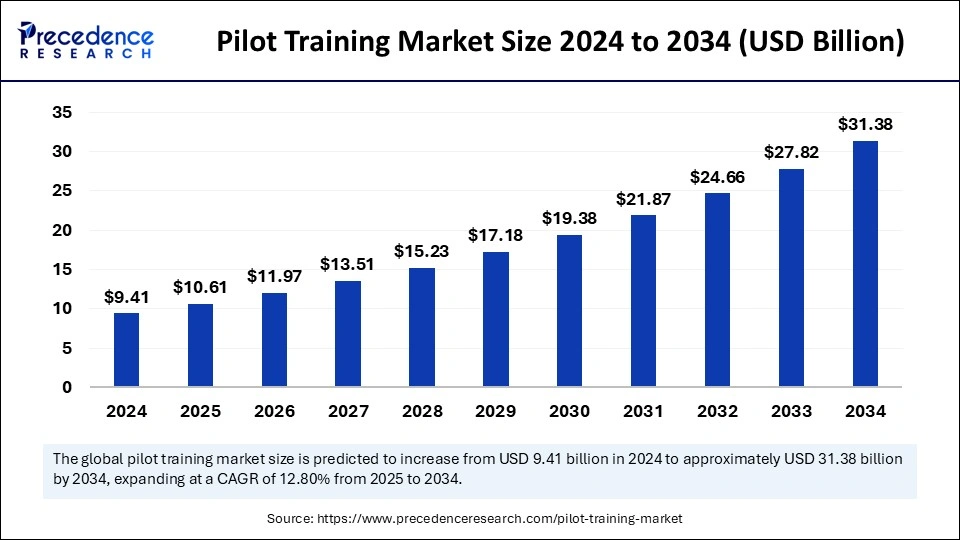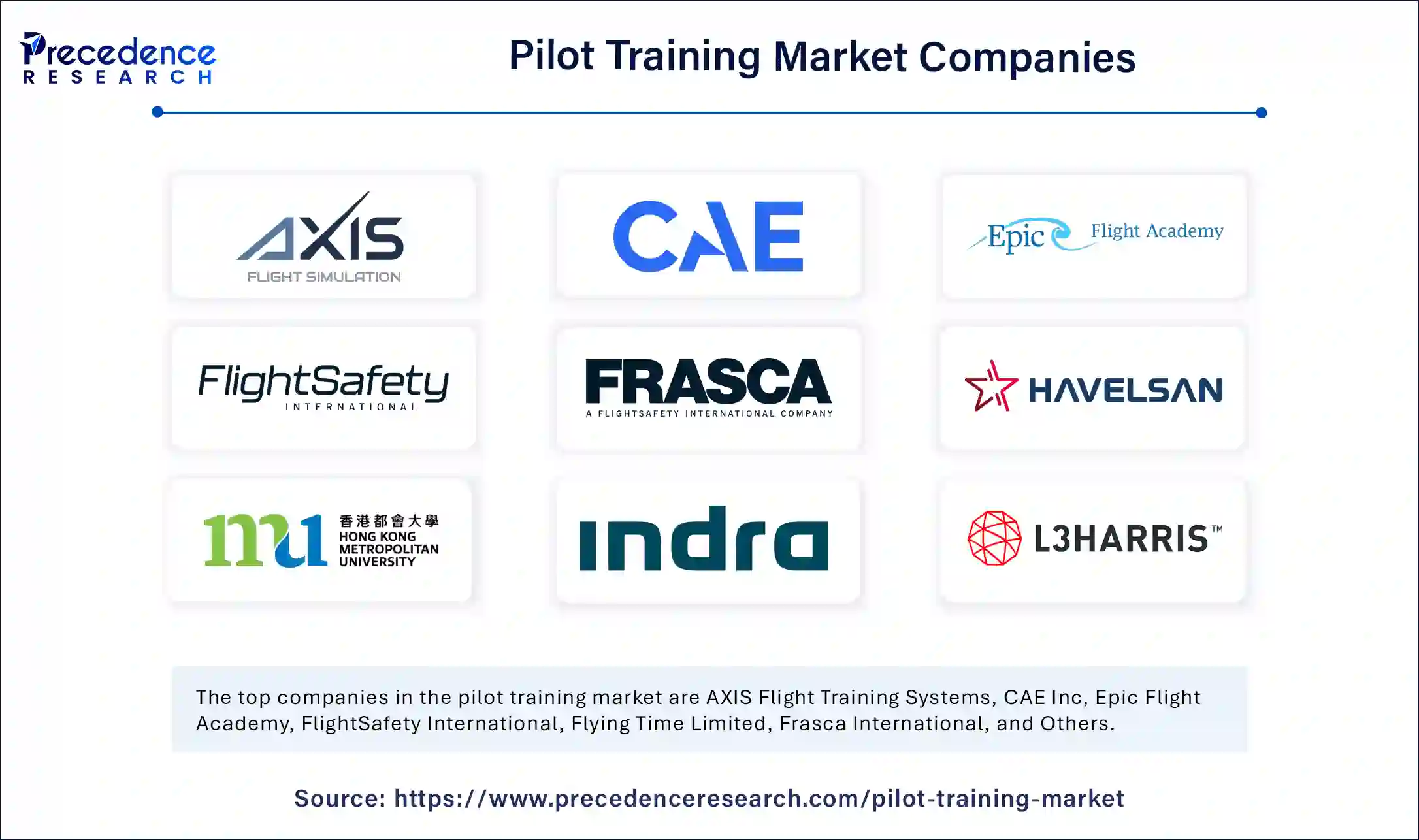Pilot Training Market Size to Surge USD 31.38 Bn by 2034
Pilot Training Market Size and Forecast 2025 to 2034
The global pilot training market size was valued at USD 9.41 billion in 2024 and is expected to surge around USD 31.38 billion by 2034, growing at a CAGR of 12.80% from 2025 to 2034.

Get a Free Sample Copy of the Report@ https://www.precedenceresearch.com/sample/5835
Pilot Training Market Key Takeaways
-
North America held the largest portion of the global pilot training market in 2024.
-
Asia Pacific is likely to grow at the highest CAGR through 2034.
-
The rotary wing category led the type segment in 2024.
-
Fixed wing training types are expected to expand notably in the forecast period.
-
The civil sector led applications in 2024.
-
The military application is forecast to record significant growth.
-
Simulators accounted for the largest component share in 2024.
-
The live training segment is expected to post robust growth through 2034.
-
Integrated systems took the lead in 2024.
-
Modular systems are projected to expand steadily over the next decade
How AI Is Revolutionizing Pilot Training with Smarter Simulations and Personalized Learning
Artificial Intelligence (AI) is playing an increasingly transformative role in the pilot training market by enhancing training efficiency, accuracy, and realism. One of the most significant contributions of AI is in flight simulation. AI-powered simulators can adapt dynamically to a trainee’s performance, offering real-time feedback and adjusting the difficulty level accordingly. These intelligent systems help create highly immersive training environments that mimic real-world flight conditions, including rare and complex scenarios that are difficult to replicate manually.
Moreover, AI is used for personalized learning paths, where algorithms analyze individual progress and tailor content to address specific weaknesses. This targeted approach improves learning outcomes and reduces training time. AI also assists in performance analytics, using data from simulators and real-time training sessions to evaluate and refine pilot competencies. Additionally, AI supports virtual instructors in remote or self-paced training setups, making pilot training more accessible and cost-effective. Through these applications, AI is elevating both the quality and accessibility of pilot training across civil and military aviation sectors.
Pilot Training Market Growth Factors
Rising Demand for Commercial Pilots: The resurgence of global air travel post-pandemic has led to a significant increase in demand for commercial pilots. Airlines are expanding their fleets and routes to accommodate growing passenger numbers, necessitating a larger pool of trained pilots.
Pilot Shortage and Retirements: The aviation industry is facing a notable pilot shortage, exacerbated by a wave of retirements and a slowdown in training during the pandemic. This shortage is prompting airlines and training institutions to accelerate pilot training programs to replenish the workforce.
Technological Advancements in Training: Innovations in simulation technology, including AI-driven and virtual reality-based training modules, are enhancing the effectiveness and efficiency of pilot training. These technologies provide realistic flight experiences and allow for safer, cost-effective training environments.Regulatory Emphasis on Safety: Aviation authorities worldwide are implementing stricter safety regulations, requiring more comprehensive and frequent training for pilots. This regulatory focus ensures that pilots are better prepared to handle various flight scenarios, thereby increasing the demand for advanced training programs.
Growth in Emerging Markets: Emerging economies, particularly in the Asia-Pacific region, are witnessing rapid growth in air travel. This expansion is leading to increased investments in pilot training infrastructure and programs to meet the rising demand for air travel in these regions.
Top Countries for Pilot Training Across the World
| Top 5 countries | Recent Advancements | Aim/Focus |
| United States | Simultaneous technologies and Integrated pilot raising solutions | The aim here is to offer both Commercial and military Programs. |
| China | Advanced flight stimulators and comprehensive pilot training. | Training programs for fixed wing And rotary aircraft . |
| Japan | State of art stimulator and a Global network of training Centers |
Providing training for commercial And business aviation pilot |
| Germany | Aircraft, integrating latest Generation simulators and flight Instructions | To offer pilot training for Airbus and aircraft |
| United Kingdom | Delivers comprehensive pilot Training services. | Addressing the growing demand |
Market Scope
| Report Coverage | Details |
| Market Size by 2034 | USD 31.38 Billion |
| Market Size in 2025 | USD 10.61Billion |
| Market Size in 2024 | USD 9.41 Billion |
| Market Growth Rate from 2025 to 2034 | CAGR of 12.80% |
| Dominated Region | North America |
| Fastest Growing Market | Asia Pacific |
| Base Year | 2024 |
| Forecast Period | 2025 to 2034 |
| Segments Covered | Type, Application, Component, System, and Regions |
| Regions Covered | North America, Europe, Asia-Pacific, Latin America, and Middle East & Africa |
Market Dynamics
Drivers
One of the primary drivers of the pilot training market is the growing demand for air travel worldwide, especially post-pandemic recovery. The expansion of airline fleets and new route developments have intensified the need for qualified pilots. Additionally, the retirement of aging pilots is contributing to a shortage, prompting urgent demand for new entrants into the profession. Advances in training technologies, such as AI-enabled simulators and virtual reality platforms, are also revolutionizing the training landscape by making learning more immersive, cost-effective, and safe.
Opportunities
Emerging markets such as Asia-Pacific, Latin America, and parts of Africa present vast opportunities for the pilot training industry. These regions are seeing increased investment in airport infrastructure and aviation capabilities, thus requiring a steady pipeline of trained aviation professionals. Moreover, the growing popularity of e-learning and remote training solutions is opening new avenues for training institutions to expand their offerings globally.
Challenges
Despite promising growth, the market faces challenges such as high costs of training and simulator equipment, regulatory complexities, and limited access to advanced training facilities in developing regions. Furthermore, the significant time and financial investment required to become a licensed pilot can deter potential candidates, contributing to the ongoing talent shortage in the aviation industry.
Regional Insights
North America currently dominates the pilot training market, backed by established training institutions, a mature aviation industry, and significant government and private sector investment. The United States, in particular, leads due to its strong defense sector and commercial aviation demand. Asia-Pacific is projected to be the fastest-growing region, driven by rapid urbanization, growing middle-class populations, and the expansion of low-cost carriers. Meanwhile, Europe continues to maintain a strong position with robust training infrastructure and regulations supporting consistent market development.
Pilot Training Market Companies

- AXIS Flight Training Systems
- CAE Inc
- Epic Flight Academy
- FlightSafety International
- Flying Time Limited
- Frasca International
- Havelsan
- Hong Kong Metropolitan University.
- Indra Sistemas
- L3 Technologies Inc
- Lufthansa Aviation Training
- Rockwell Collins
- Ryanair DAC.
- Sim-Industries
- The Boeing Company
- TRU Simulation + Training Inc
Recent Developments
- The EU Aviation Safety Agency (EASA) initiated the Pilot Competency Enhancement Program (PCEP) in 2025. This regulatory framework encourages simulator-based type rating upgrades and advanced Upset Prevention and Recovery Training (UPRT).
Countries like Germany and France provide subsidized pilot training loans under this scheme to meet the growing demand for pilots in regional airlines. - The Government of India, through DGCA (directorate general of civil aviation), announced the National Civil Aviation Training Policy 2025, establishing five regional flight training academies, incentivizing public-private Partnerships in simulator training, and introducing GST relief on flight training equipment.
- In March 2025, the Indira Gandhi Institute of Aeronautics inaugurated an AI-powered Pilot Proficiency Centre in Mumbai
Segments covered in report
By Type
- Rotary Wing
- Fixed Wing
By Application
- Civil
- Military
By Component
- Simulators
- Live Training
By System
- Integrated
- Modular
By Geography
- Asia Pacific
- North America
- Latin America
- Europe
- Middle East & Africa
Also Read: Aerospace Fasteners Market
Ready for more? Dive into the full experience on our website@ https://www.precedenceresearch.com/
